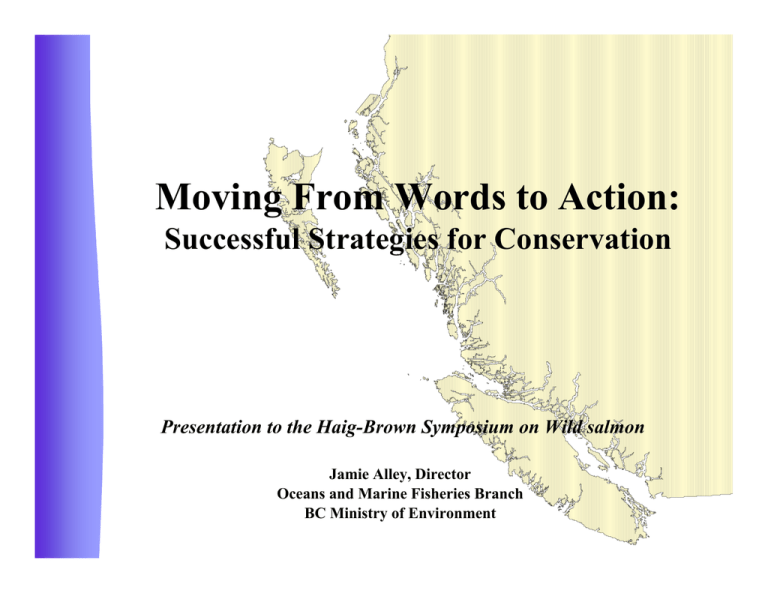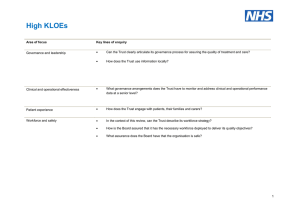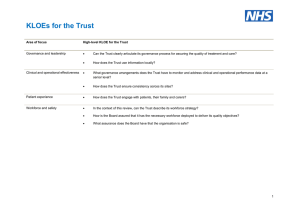Moving From Words to Action: Successful Strategies for Conservation Jamie Alley, Director
advertisement

Moving From Words to Action: Successful Strategies for Conservation Presentation to the Haig-Brown Symposium on Wild salmon Jamie Alley, Director Oceans and Marine Fisheries Branch BC Ministry of Environment An Inspiration A river is water in its loveliest form; rivers have life and sound and movement and infinity of variation, rivers are veins of the earth through which the life blood returns to the heart. A river is never quite silent; it can never, of its very nature, be quite still; it is never quite the same from one day to the next. It has its own life and beauty, and the creatures that it nourishes are alive and beautiful also. Roderick Haig-Brown, “To Know a River” from A River Never Sleeps, 1944 Best Fisheries Management “Lead the world in best environmental management with ….the best fisheries management bar none.” Great Goals for a Golden Decade, 2005 What Are the Real Culprits? Round up the usual suspects The conventional wisdom of the past - the 4 H’s: Harvesting Hydro Habitat Hatcheries BRITISH COLUMBIA SALMON CATCH Cumulative five year moving means 120,000 TONNES 100,000 80,000 60,000 20,000 SOCKEYE PINK CHUM COHO CHINOOK 2005 1990 1975 1960 1945 1930 1915 1900 1885 0 1870 TITLE 40,000 STEELHEAD Annual total British Columbia catch of salmon, 1870 to 2005, cumulated by species and presented as moving means by five, centred on the third year. Steelhead indistinguishable B.C. Commercial Catch and Spawning Escapement 2.0 1.2 Commercial Catch Spawners 0.8 0.4 (year) 20 00 19 96 19 92 19 88 19 84 19 80 19 76 19 68 19 64 0.0 19 60 TITLE Index Values (4-year average) 1.6 What Are the Real Culprits? Round up the usual suspects Today’s conventional wisdom (in addition to the 4 H’s): Climate change Ocean productivity Water flows Illegal poaching Sea lice Poor governance Globalization and materialism What will tomorrow’s conventional wisdom be? How is the Province Doing? Round up the usual suspects Auditor Generals’ Report 2004 – Assess the effectiveness of provincial programs to sustain wild salmon. Need to have a clear vision Be more active in protecting and restoring habitat Potential impacts of aquaculture being addressed but need more knowledge Better evaluation and public reporting Government’s response: Agree on need for shared vision – WSP will help Continuous improvement on habitat protection and Living Rivers Trust Fund ($21M) for restoration Establish Pacific Salmon Forum under Hon John Fraser with 3 year mandate and $5M to provide advice on securing wild salmon New performance measures in Service Plans Who should decide? From Advice to Collaboration to Co-Management Words to Action Science and management is getting much better but we haven’t changed either the culture or the governance structures (enough) Integrating fish production with fish harvesting in an ecosystem-based management process start with the ecosystem – fix any issues match harvesting to the ecosystem Water to Plate – integrating market needs What does the market want? How do we maximize value? The salmon fishery of the future: protecting and restoring the ecosystem provide broad social and community benefits Spatial Scales of Governance Addressing governance at various scales International National Fisheries Governance Mechanism Regional Transboundary Provincial Regional Local Legal Dimensions of Governance “Hard” vs. “Soft” Governance Hard Governance – Statutory laws and regulations – Permits and licenses – Treaties – Legal delegation agreements – Judicial Inquiries – Enforcement – Prison terms Soft Governance – – – – – – – – – MOUs and LOUs Policy Round Tables Advisory processes Guidelines and BMPs Traditions and values Voluntary agreements Task Forces Moral suasion Education Fisheries Governance Models Governance Arrangements Continuum of Governance Arrangements Who should decide? From Advice to Collaboration to Co-Management Words to Action Science and management is getting much better but we haven’t changed either the culture or the governance structures (enough) Integrating fish production with fish harvesting in an ecosystem-based management process start with the ecosystem – fix any issues match harvesting to the ecosystem Water to Plate – integrating market needs What does the market want? How do we maximize value? The salmon fishery of the future: protecting and restoring the ecosystem provide broad social and community benefits An Inspiration A river is water in its loveliest form; rivers have life and sound and movement and infinity of variation, rivers are veins of the earth through which the life blood returns to the heart. A river is never quite silent; it can never, of its very nature, be quite still; it is never quite the same from one day to the next. It has its own life and beauty, and the creatures that it nourishes are alive and beautiful also. Roderick Haig-Brown, “To Know a River” from A River Never Sleeps, 1944





